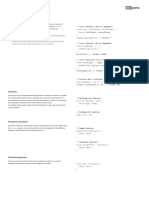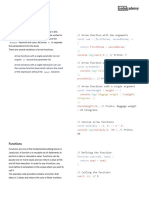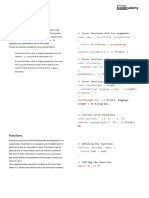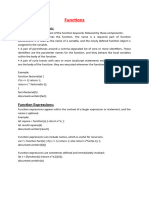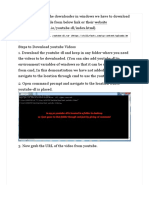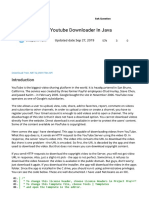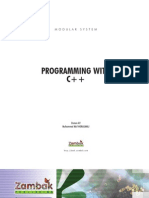0 ratings0% found this document useful (0 votes) 19K views10 pagesArrow Functions
Copyright
© © All Rights Reserved
We take content rights seriously. If you suspect this is your content,
claim it here.
Available Formats
Download as PDF or read online on Scribd
r7insi2022, 23:58 ‘Arrow function expressions - JavaScript | MON
Arrow function expressions
An arrow function expression is a compact alternative to a traditional function expression, but is
limited and can't be used in all situations.
There are differences between arrow functions and traditional functions, as well as some limitations:
* Arrow functions don't have their own bindings to this, arguments or super , and should
not be used as methods
© Arrow functions don't have access to the new.target keyword,
* Arrow functions aren't suitable for call, apply. and bind methods, which generally rely on
establishing a scope.
* Arrow functions cannot be used as constructors.
* Arrow functions cannot use yield , within its body.
Try it
Comparing traditional functions to arrow functions
Let's decompose a "traditional anonymous function" down to the simplest "arrow function” step-
by-step:
Note: Each step along the way is a valid “arrow function"
// Traditional Anonymous Function
function (a){
return a + 100;
}
// Arrow Function Break Down
// 1, Remove the word “function” and place arrow between the argument and
opening body bracket
(a) > {
return a + 100;
}
// 2. Remove the body braces and word “return” -- the return is implied.
(a) => a + 109;
// 3. Remove the argument parentheses
a => a + 109;
hitpsiideveloper mozila.orgien-USidocsiWeblavaScriptReferencelFunctionsiArrow_functons ano�r7insi2022, 23:58 ‘Arrow function expressions - JavaScript | MON
‘The { braces } and ( parentheses ) and "return" are required in some cases.
For example, if you have multiple arguments or no arguments, you'll need to re-introduce
parentheses around the arguments:
// Traditional Anonymous Function
function (a, b){
return a + b + 100;
}
// Arrow Function
(a, b) => a +b + 100;
// Traditional Anonymous Function (no arguments)
let a= 4;
let b = 2;
function (){
return a + b + 100;
+
// Arrow Function (no arguments)
let a= 4;
let b = 2;
O a+b + 100;
Likewise, if the body requires additional lines of processing, you'll need to re-introduce
braces PLUS the “return® (arrow functions do not magically guess what or when you want to
“return’):
// Traditional Anonymous Function
function (a, b){
let chuck = 42;
return a +b + chuck;
}
// Arrow Function
(a, b) => {
let chuck = 42;
return a +b + chuck;
}
And finally, for named functions we treat arrow expressions like variables
// Traditional Function
function bob (a){
return a + 100;
}
hitpsiideveloper mozila.orgien-USidocsiWeblavaScriptReferencelFunctionsiArrow_functons 210�r7insi2022, 23:58 ‘Arrow function expressions - JavaScript | MON
// Arrow Function
let bob = a => a + 100;
syntax
Basic syntax
One param. With simple expression return is not needed:
param => expression
Multiple params require parentheses. With simple expression return is not needed:
(parami, paramN) => expression
Multiline statements require body braces and return:
param => {
let a = 1;
return a + param;
}
Multiple params require parentheses. Multiline statements require body braces and return:
(param, paramN) => {
let a= 1;
return a + param + paramN;
Advanced syntax
To return an object literal expression requires parentheses around expression:
params => ({foo: “a"}) // returning the object {foo: “a"}
Rest parameters are supported:
(a, by ...r) => expression
Default parameters are supported:
hitpsiideveloper mozila.orgien-USidocsiWeblavaScriptReferencelFunctionsiArrow_functons 30�r7insi2022, 23:58
(a=400,
‘Arrow function expressions - JavaScript | MON
=20, ¢) =
expression
Destructuring within params supported:
(La, b] = [10, 20]) => a+b; // result is 30
(Ca, b } = { a: 10, b: 20 }) => a+b; // result is 30
Description
Arrow functions used as methods
As stated previously, arrow function expressions are best suited for non-method functions. Let's see
what happens when we try to use them as methods:
‘use strict’;
var obj = { // does not create a new scope
i: 10,
() => console.log(this.i, this),
cz function() {
console. log(this.i, this);
}
}
obj.b(); // prints undefined, Window {...} (or the global object)
obj.c(); // prints 19, Object {...}
Arrow functions do not have their own this . Another example
involving Object.defineProperty() :
‘use strict’;
var obj = {
a: 10
Object .defineProperty(obj, *
get: () => {
console.log(this.a, typeof this.a, this); // undefined ‘undefined’ Window
=} (or the global object)
return this.a + 10; // represents global object ‘Window’, therefore
‘this.a' returns ‘undefined’
}
Ys
of
call, apply and bind
hitpsiideveloper mozila.orgien-USidocsiWeblavaScriptReferencelFunctionsiArrow_functons ano�r7insi2022, 23:58 ‘Arrow function expressions - JavaScript | MON
The call, apply and bind methods are NOT suitable as arrow functions — as they were
designed to allow methods to execute within different scopes — because arrow functions
establish this based on the scope the arrow function is defined within.
For example call, apply and bind work as expected with traditional functions, because we
establish the scope for each of the methods:
Me
// Traditional Example
WW
// A simplistic object with its very own “this”.
var obj = {
num: 160
}
// Setting "num" on window to show how it is NOT used.
window.num = 2020; // yikes!
// A simple traditional function to operate on “this”
var add = function (a, b, c) {
return this.num +a +b +c;
}
// call
var result = add.call(obj, 1, 2, 3) // establishing the scope as “ob:
console.log(result) // result 106
// apply
const arr = [1, 2, 3]
var result = add.apply(obj, arr) // establishing the scope as “obj"
console. log(result) // result 106
// bind
var result = add.bind(obj) // establishing the scope as "obj"
console.log(result(1, 2, 3)) // result 106
With Arrow functions, since our add function is essentially created on the window (global) scope,
it will assume this is the window.
Wm
// Arrow Example
Mo
// A simplistic object with its very own "this".
var obj = {
num: 166
+
// Setting “num” on window to show how it gets picked up.
window.num = 2020; // yikes!
hitpsiideveloper mozila.orgien-USidocsiWeblavaScriptReferencelFunctionsiArrow_functons 510�r7insi2022, 23:58 ‘Arrow function expressions - JavaScript | MON
// Arrow Function
var add = (a, b, c) => this.num + a+b +c;
// call
console. 1og(add.call(obj, 1, 2, 3)) // result 2026
// apply
const arr = [1, 2, 3]
console. log(add.apply(obj, arr)) // result 2026
// bind
const bound = add.bind(obj)
console. log(bound(1, 2, 3)) // result 2026
Perhaps the greatest benefit of using Arrow functions is with methods
like setTimeout() and EventTarget.addeventListener(). that usually require some kind of
closure, call, apply or bind to ensure that the function is executed in the proper scope
Traditional function example
var obj = {
count : 10,
doSomethingLater : function (){
setTimeout(function(){ // the function executes on the window scope
this. count++;
console. log(this. count) ;
}, 300);
}
obj.doSomethingLater(); // console prints "NaN", because the property "count"
is not in the window scope.
Arrow function example
var obj = {
count : 10,
doSomethingLater : function(){
// The traditional function binds “this” to the “obj" context.
setTimeout( () => {
// Since the arrow function doesn't have its own binding and
// setTimeout (as a function call) doesn't create a binding
// itself, the "obj" context of the traditional function will
// be used within.
this. count++;
console. 1og(this.count);
}, 300);
}
obj.doSomethingLater() ;
hitpsiideveloper mozila.orgien-USidocsiWeblavaScriptReferencelFunctionsiArrow_functons ano�r7insi2022, 23:58 ‘Arrow function expressions - JavaScript | MON
No binding of arguments
Arrow functions do not have their own arguments object. Thus, in this example, arguments is a
reference to the arguments of the enclosing scope:
var arguments
var arr = ()
[1, 2, 3]5
> arguments[@];
arr()3 // 1
function foo(n) {
var f = () => arguments[@] +n; // foo's implicit arguments binding.
arguments[@] is n
return #()5
}
foo(3); // 3+3=6
In most cases, using rest parameters is a good alternative to using an arguments object.
function foo(n) {
var f = (...args) => args[@] + nj
return £(1@);
}
foo(1); // 11
Use of the new operator
Arrow functions cannot be used as constructors and will throw an error when used with new.
var Foo
var foo
O = 05
new Foo(); // TypeError: Foo is not a constructor
Use of prototype property
Arrow functions do not have a prototype property.
var Foo = () => {}5
console.log(Foo.prototype); // undefined
Use of the yield keyword
The yield keyword may not be used in an arrow function's body (except when permitted within
functions further nested within it). As a consequence, arrow functions cannot be used as
generators.
hitpsiideveloper mozila.orgien-USidocsiWeblavaScriptReferencelFunctionsiArrow_functons 70�r7insi2022, 23:58 ‘Arrow function expressions - JavaScript | MON
Function body
Arrow functions can have either a concise body or the usual block body.
Ina concise body, only an expression is specified, which becomes the implicit return value. In a
block body, you must use an explicit return statement.
var func = x => x * x;
// concise body syntax, implied "return"
var func = (x, y) => { return x + y3 }5
// with block body, explicit "return" needed
Returning object literals
Keep in mind that returning object literals using the concise body syntax params =>
{object: literal} will not work as expected.
var func = () => { foo: 1 };
// Calling func() returns undefined!
var func = () => { foo: function() {} }5
// SyntaxError: function statement requires a name
This is because the code inside braces ({)) is parsed as a sequence of statements (ie. foo is treated
like a label, not a key in an object literal).
You must wrap the object literal in parentheses
var func = () => ({ foo: 1 })5
Line breaks
An arrow function cannot contain a line break between its parameters and its arrow.
var func = (a, b, c)
=;
// SyntaxError: Unexpected token
However, this can be amended by putting the line break after the arrow or using
parentheses/braces as seen below to ensure that the code stays pretty and fluffy. You can also put
line breaks between arguments.
var func = (a, b, c)
13
Ips developer mozila orgler-USHsocsWeb JavaScript ReferencelFuncions/Aow_funcbons ano�r7insi2022, 23:58 ‘Arrow function expressions - JavaScript | MON
var func
1
3
(a, b, c) => (
var func
return 1
3
(a, b, c) => {
var func = (
a,
b,
c
yea
// no SyntaxError thrown
Parsing order
Although the arrow in an arrow function is not an operator, arrow functions have special parsing
rules that interact differently with operator precedence compared to regular functions.
let callback;
callback
callback || function() {}3 // ok
callback = callback || () => (5
// Syntaxérror: invalid arrow-function arguments
callback
callback || (() => {})3 — // ok
Examples
Basic usage
// An empty arrow function returns undefined
let empty = () => {}3
(Q => 'foobar')()5
// Returns “foobar”
// (this is an Immediately Invoked Function Expression)
var simple = a => a> 15? 15: a}
simple(16); // 15
simple(1@); // 10
let max = (a, b) => a>b? a:b
// Easy array filtering, mapping, ...
var arr = [5, 6, 13, @, 1, 18, 23]5
hitpsiideveloper mozila.orgien-USidocsiWeblavaScriptReferencelFunctionsiArrow_functons 90�r7insi2022, 23:58 ‘Arrow function expressions - JavaScript | MON
var sum = arr.reduce((a, b) => a + b);
// 66
var even = arr.filter(v => v % 2
// [6 ®, 18]
®);
var double = arr.map(v => v * 2);
// (10, 12, 26, @, 2, 36, 46]
// More concise promise chains
promise.then(a => {
Moves
}).then(b => {
Moves
Ys
// Parameterless arrow functions that are visually easier to parse
setTimeout( () => {
console. log('I happen sooner");
setTimeout( () => {
// deeper code
console.log('I happen later");
}, 1)5
5
hitpsiideveloper mozila.orgien-USidocsiWeblavaScriptReferencelFunctionsiArrow_functons
10110









